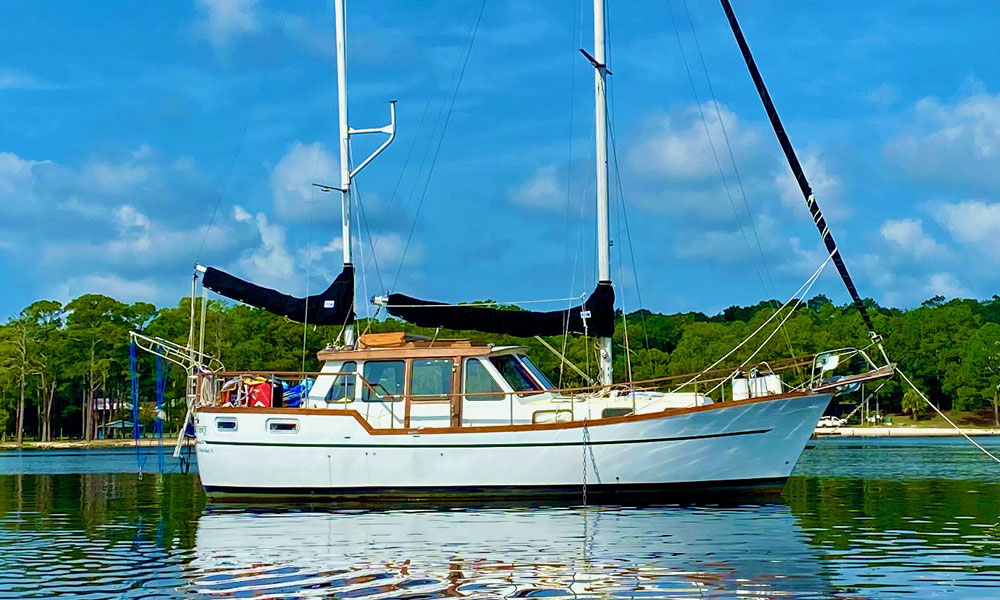- Home
- Cruising Yachts 30' to 35'
- Nauticat 33
The Nauticat 33 Sailboat
The Nauticat 33, a popular live-aboard ketch, was designed by W. Aarnipalo and built in Finland by Siltala Yachts.
 The hull of this Finnish-built Nauticat 33 motorsailer closely resembles that of a traditional Nordic fishing boat. She's a popular cruising yacht for the liveaboard sailor.
The hull of this Finnish-built Nauticat 33 motorsailer closely resembles that of a traditional Nordic fishing boat. She's a popular cruising yacht for the liveaboard sailor.Published Specification for the Nauticat 33
Underwater Profile: Long keel
Rig: Ketch
Length Overall: 33'2" (10.1m)
Waterline Length: 28'2" (8.6m)
Beam: 10'8" (3.3m)
Draft: 5'1" (1.6m)
Displacement: 17,250lb (7,824kg)
Ballast: 5,150lb (2,336kg)
Construction: GRP (fiberglass)
Built by: Siltala Yachts (Finland)
Designed by: W. Aarnipalo
First Built: 1967
Published Design Ratios for the Nauticat 33
1. Sail Area/Displacement Ratio: 11.4
2. Ballast/Displacement Ratio: 29.9
3. Displacement/Length Ratio: 344
4. Comfort Ratio: 38.4
5. Capsize Screening Formula: 1.7
Summary Analysis of the Design Ratios for the Nauticat 33
1. A Sail Area/Displacement Ratio of just 11.4 suggests that the Nauticat 33 will need a stiff breeze to get her going. In light conditions, unless you've got plenty of time on your hands, motor-sailing may be the way to go.
2. A Ballast/Displacement Ratio of 29.9 means that unless the bulk of the ballast is concentrated in a bulb at the foot of her keel, the Nauticat 33 will have a tendency to heel excessively in a gust, and she'll need to be reefed early to keep her sailing upright in a moderate breeze.
3. A Displacement/Length Ratio of 344, tells us the Nauticat 33 is clearly a heavy displacement cruising boat. You can load her down with all your cruising gear and equipment and it will hardly affect her waterline. Not an ideal choice for coastal sailing, but she'll come into her own on an offshore passage in testing conditions.
4. Ted Brewer's Comfort Ratio of 38.4 suggests that crew comfort of a Nauticat 33 in a seaway is similar to what you would associate with the motion of a moderate bluewater cruising boat - a predictable and acceptable motion for most seasoned sailors.
5. The Capsize Screening Formula (CSF) of 1.7 tells us that a Nauticat 33 would be a safer choice of sailboat for an ocean passage than one with a CSF of more than 2.0.
A Few FAQs...
Is the Nauticat 33 still in production and, if not, when did production end and how many of these sailboats were built?
Is the Nauticat 33 still in production and, if not, when did production end and how many of these sailboats were built?
The Nauticat 33 is no longer in production. The last Nauticat 33 was built in 1996 after a production run of almost 30 years, during which more than 1200 Nauticat 33s were built.
What, if any, alternative versions of the Nauticat 33 were built?
What, if any, alternative versions of the Nauticat 33 were built?
There were two main versions of the Nauticat 33: the MkI and the MkII. The MkI boats (pre-1977 with hull numbers 1 to 440) had a long shoal-draft, encapsulated keel and a wooden wheelhouse. The MkII boats (post-1977 with hull numbers 441 to 1265) had a shorter fin keel with a skeg-hung rudder and a fibreglass wheelhouse. In addition, some MkII boats had a raised aft deck as an option. An updated model, the Nauticat 331, was introduced in 1997.
What is the difference between the Nauticat 33 and the Nauticat 331?
What is the difference between the Nauticat 33 and the Nauticat 331?
The Nauticat 331 is a newer and slightly larger version of the Nauticat 33, built by the same Finnish company, Siltala Yachts. It has a length of 10.4 m (34'1") compared to the Nauticat 33's 10.1 m (33'2"). It also has a deeper fin keel with a draft of 1.48 m (4'10") compared to the Nauticat 33's 1.4 m (4'7") or 1.8 m (5'11"). The Nauticat 331 has a similar layout and design as the Nauticat 33, but with some modern updates and improvements. The Nauticat 331 was built between 1999 and 2018, while the Nauticat 33 was built between 1966 and 1994.
How did the sailing press review the Nauticat 33?
How did the sailing press review the Nauticat 33?
The sailing press generally gave positive reviews to the Nauticat 33, praising its quality, comfort, and seaworthiness. For example, Yachting Monthly described the Nauticat 33 as "an attractive and solid motorsailer that will cruise at around 5 knots" and "a boat that will look after you in all weathers".
What is the history of the builders of the Nauticat 33 and is the company still in business?
What is the history of the builders of the Nauticat 33 and is the company still in business?
The builders of the Nauticat 33 were Siltala Yachts, a family-owned company founded by Pentti Siltala in Finland in 1964. Siltala Yachts specialised in producing motorsailers under the brand name Nauticat. The company was one of the leading manufacturers of motorsailers in Europe, with more than 2800 boats delivered to over 40 countries. Unfortunately, Siltala Yachts ceased operations in 2018 due to financial difficulties.
How many people can sleep on board a Nauticat 33?
How many people can sleep on board a Nauticat 33?
The Nauticat 33 can sleep up to six people on board, depending on the layout. The standard layout has two double cabins: one forward with a V-berth and one aft with an offset double berth. There is also a convertible dinette in the saloon that can be turned into another double berth. Some boats may have different layouts, such as a single berth in the aft cabin or a U-shaped dinette in the saloon.
What keel options, if any, are available for the Nauticat 33?
What keel options, if any, are available for the Nauticat 33?
The Nauticat 33 has two keel options: a long keel and a fin keel. The long keel is found on the MkI boats and has a draft of 1.4 m (4'7"). The fin keel is found on the MkII boats and has a draft of 1.8 m (5'11"). The long keel offers more stability and directional stability, while the fin keel offers more maneuverability and performance.
What is the Nauticat 33 like to sail?
What is the Nauticat 33 like to sail?
The Nauticat 33 is not a fast or agile sailboat, but rather a steady and comfortable one. It is designed to handle rough seas and strong winds with ease, thanks to its heavy displacement, high freeboard, and powerful engine. It is also well-balanced and easy to sail, with good visibility from both the cockpit and the wheelhouse. The Nauticat 33 is ideal for long-distance cruising, coastal hopping, or living aboard.
What is the average cost of a secondhand Nauticat 33?
What is the average cost of a secondhand Nauticat 33?
The average cost of a secondhand Nauticat 33 varies depending on the age, condition, equipment, and location of the boat. According to YachtWorld, the current price range for a used Nauticat 33 is from £29,950 to £79,950, with an average price of £49,950.
The above answers were drafted by sailboat-cruising.com using GPT-4 (OpenAI’s large-scale language-generation model) as a research assistant to develop source material; to the best of our knowledge, we believe them to be accurate.
Recent Articles
-
Is An SSB Marine Radio Installation Worth Having on Your Sailboat?
Apr 14, 25 02:31 PM
SSB marine radio is expensive to buy and install, but remains the bluewater sailors' favourite means of long-range communication, and here's why -
Correct VHF Radio Procedure: Your Questions Answered
Apr 14, 25 08:37 AM
Got a question about correct VHF radio procedure? Odds are you'll find your answer here... -
VHF Marine Radio; Which One is Right for Your Boat?
Apr 14, 25 05:09 AM
If you're looking to buy a VHF Marine Radio the choice can be a bit overwhelming. So what should it be, a fixed VHF or a handheld VHF? Maybe one with AIS or GPS built in perhaps?













